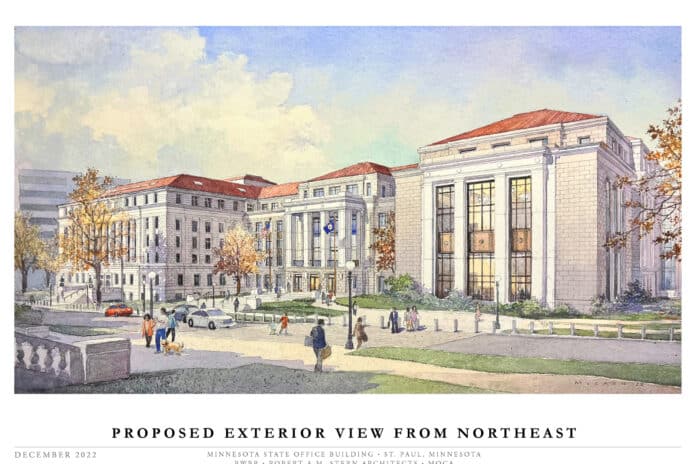
Despite repeated complaints from several Republican legislators over the last year on the size and scope of what will turn out to be the costliest Minnesota Capitol renovation in state history, work on the State Office Building project is expected to begin in just a matter of weeks.
While the project is expected to have an impact on the daily tasks of those engaged in legislative activities for the next three sessions, some lawmakers want to make sure the cost to taxpayers doesn’t go unnoticed.
Earlier this month House Minority Leader Lisa Demuth, R-Cold Spring, criticized the anticipated price tag of the project, which could cost taxpayers nearly three quarters of a billion dollars when it is paid off in 2044.
The reason? A DFL-controlled House of Representatives committee approved the project almost a year ago knowing the state would be borrowing its own debt to finance the cost.
In December 2022 legislators in the House Rules and Legislative Administration Committee and officials with the Department of Administration were quoting a project cost of more than $450 million. While Republicans in those hearings blasted the cost of the project, they aren’t necessarily blameless.
A 2021 state government finance bill that passed in the DFL-majority House, Republican-controlled Senate, and was signed into law by Gov. Tim Walz included a provision that would allow the prospective State Office Building’s renovation to be managed — including the cost and scope — by the building’s major tenant, the House of Representatives. That wrinkle allowed then-House Majority Leader Ryan Winkler, who also chaired the House Rules and Legislative Administration Committee, to principally drive the project scope of the project, without any necessary budget approvals from the Senate.
“We are at end-of-life for the State Office Building as it is today,” Winkler said at a December 2022 hearing on the project where lawmakers listened as state officials explained the condition of the building and the necessary repairs needed in its next major renovation.
Officials with the Department of Administration surveyed a number of components throughout the building they assessed as in good (foundation, exterior walls, floor coverings, interior walls, doors and stairs) or excellent condition (floors, floor structure, roof structure). But they handed out poor ratings to plumbing, HVAC, roof covering and window components. They also determined many spaces in the building were not ADA compliant.
House Republicans call renovation ‘fiscal insanity’
Over the next several months, as the Department of Administration began finalizing the stages of completion, legislators and the public came to grips with the costs the state was about to incur.
Just a few weeks ago the Office of Minnesota Management and Budget sent a letter to House Minority Leader Demuth that confirmed the total cost of the loan the state has taken out for the State Office Building renovation could potentially increase those costs to $730 million, after interest accrues.
From the Oct. 26 sale, “the state will pay at the very most a total of $729,321,190.97 through 2044, or about $35.9 million annually,” wrote Management and Budget Commissioner Erin Campbell. “As part of MMB’s ongoing responsible management of the state’s debt portfolio, we will look for opportunities to refinance the COPs in the future and achieve interest rate savings so the final cost could be less.”
In late October, state officials with the Department of Administration signed off on a sale of $454 million in debt to finance the project that has been in the works for more than two years. In that sale, the state locked into a 4.39 percent interest rate with Jefferies LLC, a global banking and capital markets firm that has offices in New York, London and Hong Kong.
“The interest alone — $275 million — on Democrats’ luxury office building is almost as much as was spent on the entire renovation of the Minnesota Capitol,” Demuth said in a statement earlier this month. “That is fiscal insanity.”
“It did not have to be this way — there were alternative, less costly options to renovating the State Office Building. But Democrats refused to consider anything less than their extravagant plans. Minnesotans should not be on the hook for a $730 million office building for 134 politicians. This is beyond irresponsible.”
Project impacts on legislative business will begin with tunnel closure
Democrats have downplayed criticism over the cost when the topic of the project has come up over the last 12 months. Erected in 1932 and last renovated 40 years ago, the State Office Building is home to the 134-member House of Representatives and its more than 200 support staff. It also houses the Office of the Secretary of State, the Legislative Reference Library and the Legislative Budget Office.
While the State Office Building project is being officially branded as a renovation, crews will construct an addition to the 91-year-old building, along with extensive interior and exterior improvements.

While the Department of Administration, which manages buildings owned by the state, continues to commit to officially starting the project next month, legislators and their staff aren’t expected to be displaced from the State Office Building until the end of the 2024 legislative session.
When that phase of the project begins, the House will conduct its business temporarily in the Centennial Office Building on the other side of the Capitol complex, which could make for logistically challenging legislative sessions for staff and the public in 2025 and 2026.
The project is expected to be wrapped up in 2026.
Those who plan to visit or do business at the Capitol during the legislative session, which begins on Feb. 12, will have to dress for the weather. As renovation crews begin their work in the coming weeks, they plan to close the underground tunnel that connects the State Office Building and the Capitol building. That is expected to take place prior to the start of the legislative session, which means lobbyists, staff, and members of the public who shuffle between the House and Senate chambers, offices and hearing rooms, will have to do so above ground in the elements.
‘A basilica to government’
The State Office Building renovation follows a $310 million renovation of the Capitol building across the street. That project was completed in 2017 after an extensive rehabilitation that stretched over four years, where at times, meeting spaces for legislators were impacted and shifted around. Just a year prior, in 2016, a newly constructed Senate Office Building, which sits across the street to the north of the State Capitol, was completed for $90 million.
Republicans pointed to that context last December when debating how much renovation was needed in the SOB.
“We are now going to put forward a proposal for likely a half billion dollars to build a — I don’t want to call it a cathedral to government, because that’s across the street at the Capitol,” said Rep. Jim Nash, R-Waconia. “But this is … maybe a basilica towards government. I would just urge less spending on this one.”
Ultimately, DFL legislators in the committee outnumbered Republicans on approval of the project on a split voice vote.
A number of Republicans this fall continued to criticize the scope and ballooning cost of the project, even before the revelation that accrued interest could increase the total cost of the project by a quarter billion dollars.
“I am urging @GovTimWalz & MMB Commissioner Campbell to halt the $500 million remodel of the State Office Building. Politicians do not need a new, half a billion-dollar office building when families are facing higher prices for gas, groceries, and energy bills,” said Rep. Kristin Robbins, R-Maple Grove.
Many DFL legislators defended the project, including Rep. Nathan Coulter, a former DFL state Senate staffer, who endured through his fair share of renovation challenges.
“The State Office Building is more than just offices for politicians,” Coulter, of Bloomington, said. “It’s where folks file businesses with the SOS, where staff of all partisan stripes work diligently, and where members of the public interact with elected leaders. And it desperately needs to be redone.”
A recent column by Center of the American Experiment fellow Bill Glahn pointed out among the new amenities planned as part of the renovation is a private balcony on the fifth floor, which is generally occupied by the majority party.
“Members of the House of Representatives will be able to wave to the adoring crowds from high above the state capitol grounds in St. Paul,” Glahn wrote.
Hank Long
Hank Long is a journalism and communications professional whose writing career includes coverage of the Minnesota legislature, city and county governments and the commercial real estate industry. Hank received his undergraduate degree at the University of Minnesota, where he studied journalism, and his law degree at the University of St. Thomas. The Minnesota native lives in the Twin Cities with his wife and four children. His dream is to be around when the Vikings win the Super Bowl.












